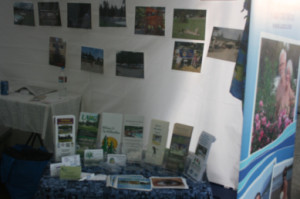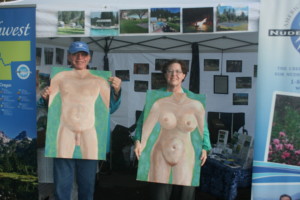These rides are protests against “big oil”.
MORNING NAKED RIDE
Irving Park, NE 7th Ave and Fargo St, Portland Take Trimet (Near Basketball Pavillion)
11:00am – 2:00pm
Start the WNBR day right with a morning naked ride. Or warm jacket and bottomless ride. We’ll wander quiet streets, enjoy body acceptance. Bring body paint, caps and warm socks. Bare as you dare.
This ride will end at Coe Circle for a picnic lunch before the Sunny Nekid Ride and the night-time ride. If you add all these up you’ll be riding naked all day!
Policy of no photos by ride participants.
Ker Nal And Pas’t Tire, ted101at gmaildaht comm [forum]
NAKED METRIC CENTURY
Irving Park, NE 7th Ave and Fargo St, Portland Take Trimet (Meet near Basketball Pavillion)
11:00am – 11:00pm
Ride 100 km naked — we’ll string together the 4 sunny naked rides and the night ride. Morning Naked, Sunny Nekkid, Fig Leif Naked, St. Johns Naked, and WNBR.
Bring body paint and sun hats.
Cameras discouraged.
SUNNY NEKKID RIDE
Coe Circle, 3900 NE Glisan St Take Trimet
2:00pm – 4:30pm
Fun ride in the sun, celebrate body freedom, bring paint for self expression & messages. Clothing optional, cameras discouraged.
This is the biggest day-time nekid ride. We’ll ride through all five quadrants of Portland. Busy streets, quiet streets and paths. Ride ends in NW at the Fig Leif Ride.
Policy of no photos by ride participants.
FIG LEIF NAKED BIKE RIDE
Forest park, top of NW Thurman St. Take Trimet (500 yards beyond the entry gate by the Port-a-Potties)
5:00pm – 6:30pm
Naked 10K off road bike ride on NW Leif Erickson Road at 5:00 pm Saturday, June 7th. This is an uphill ride over a bumpy road to St Johns. This ride is scheduled to start after the Sunny Nekkid Ride and end in time for everyone to join the St Johns Naked Ride at 6;45 pm which in turn will ride to the start of the night time World Naked Bike Ride. Meet by the Port-a-Potties about 500 yards beyond the entry gate at the top of NW Thurman St hill. Please, cameras are discouraged.
Henry, Henry5Kmat gmaildaht comm [forum]
ST. JOHNS NAKED RIDE
Block Bikes PDX LLC, 7238 N Burlington Ave Take Trimet (We’ll move over to the plaza across the street if we run out of sidewalk.)
6:45pm – 7:45pm
We’ll ride the 10 miles together to the start of the WNBR from St. Johns. We will take side streets as much as possible and be as nude as desired. We’ll ride slowish, but faster than the WNBR. I highly encourage safe cycling…especially when partially nude.
Block Bikes, bikeshopat blockbikespdxdaht comm [forum]
WORLD NAKED BIKE RIDE
Normandale Park, NE 56th Ave and NE Halsey Take Trimet (DO NOT BLOCK HALSEY)
8:00pm, meet at 8pm, depart at 9pm
This year’s largest, evening naked bike ride will take place at sunset! Join us at 8pm to get amped up to strip down, hang out and ride.
RIDE IS NOT A LOOP – and will end several miles from the start point. Please plan accordingly (bring a map or smartphone to help you route back to the start).
Ride departs at 9. Please do not trash the park, please be safe on your bike (wear shoes and a helmet!) and respectful to others. While basic mechanic service may be available on-site, please have your bike tuned up before arrival.
WNBR Team, pdxwnbr.org, theworldnakedbikerideat gmaildaht comm [forum]
WNBR AFTER RIDE – LATE NIGHT FOOD CARTS
Lillis Albina City Park, N Russell and Flint Ave. Take Trimet (Meet 15 Minutes after the end of the World Naked Bike Ride)
11:30pm
Join Food Carts 4 Charity for an After the World Naked Bike Ride to some Late Night Food Carts around town.
Bring $ for food, Clothing Optional
We will meet shortly after the end of the World Naked Bike Ride and head to some Food Carts that are open.
Our route will be determined by where the WNBR ride ends but you can count on going to the following locations at a minimum.


